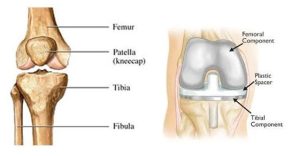A total knee joint replacement is a surgical procedure which replaces the original joint surfaces with prosthetic substitutes. The knee joint in a ‘hinge’ joint, with the Femoral Condyles forming the superior surface and the Tibial Plateau forming the inferior surface. The surgery involves the removal and replacement of the joint surface of the Femur and the Tibia. Occasionally, a total knee replacement may involve the under surface of the patella being replaced.

Surgery to replace the knee joint is a common procedure that is performed by an Orthopaedic Surgeon. Joint replacement surgery is usually performed when the knee has severe osteoarthritis, causes significant pain and reduces a person’s ability to continue to lead an active and healthy lifestyle. It is not uncommon for Orthopaedic Surgeons to encourage patients to hold off having surgery if it is not yet affecting their everyday tasks.
Rehabilitation is essential following total knee joint replacement to ensure a positive outcome without complications is reached. Physiotherapy focuses on restoring range of motion, strength and function after surgery. There is often an extensive and targeted exercise program which is designed to quicken recovery, strengthen, improve flexibility and assist with pain management.
Initially a patient will be taught how to walk using a gait aid, such as crutches or a frame, and then be progressed to walking aid free. In normal circumstances, a surgeon will have few precautions to impose on your rehabilitation and encourage patients to ‘listen to their knee.’ This means the patient is allowed to slowly increase their activity level so long as there is no increase in pain and swelling. Contact your physiotherapist is best placed to advise you on pacing and exercise adherence.
